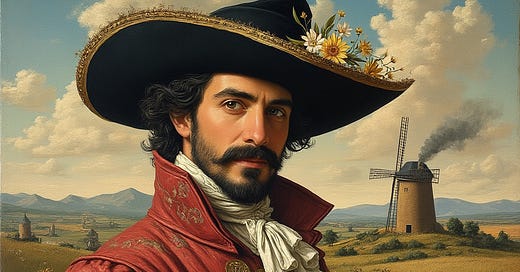Miguel de Cervantes: The Mind Behind the Man Who Challenged Chivalry
Honoring the Satirists and Thinkers Who Altered Our Perspectives #40
Voice-over provided by Amazon Polly
Also, check out Eleven Labs, which we use for all our fiction.
Preface
As we continue our series on influential literary and intellectual figures whose recognition often falls short of their significant contributions, we reach our 40th feature: Miguel de Cervantes. In line with our exploration of the 39 notable individuals who came before him, we aim to shed light on the life and work of a creator whose impact on global culture surpasses his personal fame.
Cervantes is a towering figure in literature, best known for his masterpiece, Don Quixote. While this novel is widely celebrated as a foundational work in world literature, the man behind it—a writer whose life was filled with as much drama and complexity as his characters—merits a closer look. Cervantes’ sharp wit and keen observations revolutionized storytelling and employed satire to challenge and reshape societal norms.
Our exploration of Cervantes continues our series' goal of honoring those writers and thinkers who, through their distinct voices, have significantly influenced our view of the world. Just like the overlooked satirists and philosophers we've previously featured, Cervantes’ legacy extends well beyond his most renowned work, offering insights that are still strikingly relevant today.
The Man Behind the Quixotic Tale
Born in 1547 in Alcalá de Henares, a small town near Madrid, Miguel de Cervantes Saavedra entered a world on the cusp of great change. Spain was at the height of its golden age, yet for Cervantes, life was far from gilded. His early years were marked by financial hardship and frequent relocations as his father, a barber-surgeon with a penchant for gambling, sought to escape creditors.
Despite these challenges, young Miguel developed a passion for literature, possibly nurtured by his time at a Jesuit school in Seville. However, the path that led to his literary greatness was circuitous and fraught with peril. In 1570, Cervantes fled Spain for Italy, possibly to escape punishment for wounding a man in a duel. This exile proved fortuitous, exposing him to the Renaissance humanism that would later infuse his works.
Cervantes' life took another dramatic turn when he enlisted as a soldier in the Spanish Navy Marines. In 1571, he fought valiantly in the Battle of Lepanto, sustaining injuries that left his left hand permanently maimed—a wound he would proudly bear as a badge of honor throughout his life. But fate had not finished with Cervantes. In 1575, while returning to Spain, he was captured by Barbary pirates and spent the next five years as a slave in Algiers.
These experiences—of war, captivity, and the struggle for freedom—profoundly shaped Cervantes' worldview. They imbued him with a deep understanding of human nature, from its noblest aspirations to its basest instincts. This hard-earned wisdom would later manifest in the complex characters and nuanced social commentary of his writings.
Upon his return to Spain in 1580, Cervantes found himself in a nation resistant to change, clinging to outdated ideals of chivalry and honor. It was against this backdrop that he began his literary career, initially as a playwright. However, success eluded him in this endeavor, and he took on a series of government jobs, including that of a tax collector—a position that would ironically lead to his imprisonment due to irregularities in his accounts.
It was during one of his stints in prison that Cervantes is said to have conceived the idea for "Don Quixote." This masterpiece, born from adversity, would go on to change the course of literature and establish Cervantes as one of the most influential satirists in history.
Don Quixote: A Revolutionary Satire
Published in two parts (1605 and 1615), "Don Quixote" is more than just a story of a deluded knight and his loyal squire. It is a multifaceted satire that takes aim at the chivalric romances popular in Cervantes' time while simultaneously exploring deeper themes of identity, reality, and the human condition.
The novel's protagonist, Alonso Quixano, is an aging gentleman who becomes so enamored with tales of knight-errantry that he loses his grip on reality. Renaming himself Don Quixote de La Mancha, he sets out on a series of misadventures, accompanied by his practical-minded squire, Sancho Panza. Through their travels, Cervantes masterfully lampoons the conventions of chivalric literature, exposing the absurdity of its unrealistic ideals.
One of the most famous episodes, the tilting at windmills, perfectly encapsulates Cervantes' satirical genius:
"Just then, they came in sight of thirty or forty windmills that rise from that plain. And no sooner did Don Quixote see them that he said to his squire, 'Fortune is guiding our affairs better than we ourselves could have wished. Do you see over yonder, friend Sancho, thirty or forty hulking giants? I intend to do battle with them and slay them.'"
This scene not only mocks the exaggerated battles found in chivalric romances but also serves as a poignant metaphor for the futility of clinging to outdated ideals in the face of a changing world.
Cervantes' satire, however, goes beyond mere parody. Through the interplay between Don Quixote's idealism and Sancho Panza's pragmatism, he explores the tension between imagination and reality, illusion and truth. This dynamic allows Cervantes to critique not just literary conventions but also societal norms and human nature itself.
The novel's structure is equally revolutionary. Cervantes employs a complex narrative framework, including a fictional Arab historian as the purported author of Don Quixote's tale. This metafictional approach allows Cervantes to comment on the nature of storytelling itself, blurring the lines between fiction and reality in a way that was unprecedented for its time.
Moreover, Cervantes uses his characters to voice critiques of contemporary Spanish society. Through Don Quixote's encounters with various social classes—from shepherds to dukes—Cervantes exposes the hypocrisies and injustices of his time. His satire touches on issues of class, religion, and politics, often with a subtlety that allowed him to evade censorship while still conveying powerful messages to his readers.
Beyond Don Quixote: Cervantes' Other Works
While "Don Quixote" is undoubtedly Cervantes' masterpiece, his other works also demonstrate his satirical prowess and literary innovation. His collection of short stories, "Novelas Ejemplares" (Exemplary Novels), published in 1613, showcases his versatility as a writer and his ability to infuse even shorter forms with social commentary.
In "Rinconete y Cortadillo," for instance, Cervantes presents a satirical view of Seville's underworld, exposing the organization and quasi-respectability of its criminal elements. Through the eyes of two young picaros (rogues), he paints a picture of a society where crime is just another profession, challenging readers to question the boundaries between legality and morality.
Another notable work is "Los trabajos de Persiles y Sigismunda" (The Travails of Persiles and Sigismunda), published posthumously in 1617. While ostensibly a Byzantine romance, this novel also contains elements of satire, particularly in its treatment of religious and cultural differences. Cervantes uses the journey of his protagonists to explore themes of tolerance and understanding, subtly critiquing the religious orthodoxy of his time.
These works, along with his plays and poetry, demonstrate that Cervantes' satirical eye was not limited to chivalric romances. Rather, he applied his wit and insight to a wide range of social and cultural phenomena, always seeking to expose truth through humor and irony.
Cervantes' Impact and Legacy
The influence of Cervantes, particularly through "Don Quixote," on subsequent literature and thought cannot be overstated. He is often credited with inventing the modern novel, inspiring generations of writers to experiment with narrative structure and character development.
Authors as diverse as Gustave Flaubert, Fyodor Dostoevsky, and Jorge Luis Borges have acknowledged their debt to Cervantes. His influence can be seen in works like Flaubert's "Madame Bovary," where the protagonist's romantic delusions echo those of Don Quixote, and in the metafictional techniques employed by postmodern authors.
Beyond literature, Cervantes' ideas have permeated philosophy, psychology, and popular culture. The term "quixotic" has entered the lexicon to describe idealistic but impractical pursuits. Don Quixote himself has become an archetype, representing the eternal struggle between idealism and reality.
Cervantes' satirical approach—gentle yet incisive, humorous yet profound—has provided a model for social critique that remains relevant today. His ability to use comedy to address serious issues, to challenge societal norms while maintaining empathy for his characters, offers valuable lessons for modern satirists and social commentators.
Relevance in the Modern World
In an era of "fake news" and "alternative facts," Cervantes' exploration of the relationship between illusion and reality feels remarkably prescient. Don Quixote's inability to distinguish between fantasy and reality, and his insistence on interpreting the world through the lens of chivalric romances, mirrors contemporary concerns about echo chambers and confirmation bias.
Moreover, Cervantes' critique of outdated social structures and rigid thinking resonates in our rapidly changing world. Just as Don Quixote clung to an idealized past, many today resist societal changes, preferring comfortable illusions to complex realities. Cervantes reminds us of the importance of adapting our worldviews in the face of new information and changing circumstances.
The novel's treatment of class and social justice also remains relevant. Through characters like Sancho Panza, Cervantes gives voice to the common people, challenging the notion that wisdom and virtue are the exclusive domain of the upper classes. This democratizing impulse feels particularly pertinent in our age of growing inequality and social unrest.
Finally, Cervantes' use of humor to address serious issues provides a valuable model for contemporary discourse. In a time of increasing polarization, his ability to critique without demonizing, to challenge ideas while maintaining empathy for those who hold them, offers a path towards more constructive dialogue.
Conclusion: The Enduring Power of Cervantes' Satire
Miguel de Cervantes, through his masterful use of satire, did more than entertain—he changed the way we think about literature, society, and ourselves. His works, particularly "Don Quixote," continue to challenge readers to question their assumptions, to look beyond appearances, and to find humor and humanity even in life's most difficult moments.
Cervantes' legacy reminds us of the power of satire to shape societal perspectives. By holding up a mirror to society's follies and contradictions, he invited readers to laugh at themselves and, in doing so, to grow. His work demonstrates that effective satire is not merely destructive; it can be a constructive force, clearing away outdated ideas to make room for new ways of thinking.
As we face the complexities of the 21st century, Cervantes' insights remain as relevant as ever. His ability to balance idealism with pragmatism, to find humor in adversity, and to challenge societal norms while maintaining compassion for human frailty, offers a roadmap for navigating our own turbulent times.
In honoring Cervantes, we celebrate not just a great writer, but a transformative thinker whose work continues to shape our understanding of literature, society, and the human condition. His life and works remind us that even in the face of adversity, creativity and humor can be powerful tools for change. As we confront our own windmills, real or imagined, we would do well to approach them with the wit, wisdom, and indomitable spirit of Miguel de Cervantes.
As the 40th installment in our series, Cervantes stands as a testament to the enduring power of overlooked voices in shaping our cultural landscape. His journey from struggling writer to literary giant serves as an inspiration, reminding us that greatness often emerges from the most unexpected places. In exploring Cervantes' life and works, we continue our mission of bringing deserved recognition to those thinkers and creators who, despite their profound impact, have not always received their due in the annals of history.
Thank you for your time today. Until next time, stay gruntled.
Do you like what you read but aren’t yet ready or able to get a paid subscription? Then consider a one-time tip at:
https://www.venmo.com/u/TheCogitatingCeviche
Ko-fi.com/thecogitatingceviche







